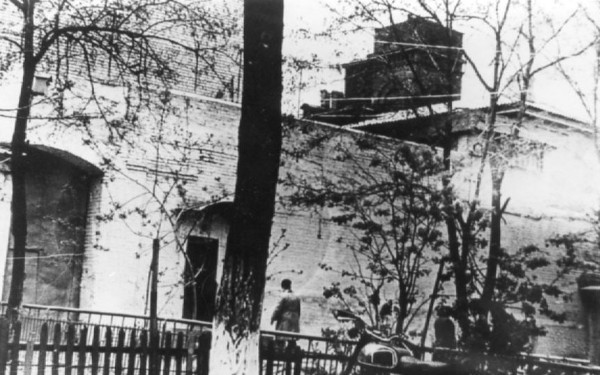Psychiatric hospitals, special
Psychiatric hospitals, special. The main difference between regular and special psychiatric hospitals (Ukrainian slang: psykhushky) was that the former fell under the jurisdiction of the Ministry of Health whereas the latter were under the direct jurisdiction of the MVD. In the special psychiatric hospitals (SPH) security factors were given priority over medical considerations, and instances of abuse of psychiatry for political purposes were common. A person could be sentenced, without right of appeal, to ‘compulsory psychiatric treatment’ for ‘anti-Soviet agitation and propaganda’ (Article 70 of the Criminal Code of the USSR), ‘circulation of fabrications known to be false which defame the Soviet state and social system’ (Article 190–1), ‘betrayal of the Fatherland’ (Article 64), or ‘illegally leaving the country and illegally entering the USSR’ (Article 83).
As late as the 1980s there were SPH operating in the USSR, with two new SPH known to have been established in 1972 (see table). The most notorious SPH was the Sichevka. Female patients consigned to involuntary psychiatric treatment were invariably taken to Kazan. One SPH was located in Ukraine, in Dnipropetrovsk; like most others it was housed in a former prison. Until the mid-1950s SPH were officially classified as prison institutions or places of detention. They were surrounded by walls as well as barbed wire and guarded by military personnel with dogs. Personnel, including hospital directors, heads of departments, and many of the psychiatrists (who were not obliged to tell their full names to the inmates or their relatives), were officers in the MVD. Many sanitary orderlies were convicts recruited from the penitentiary system, and they were granted the authority to maintain discipline among patients.
The patients of the SPH were committed there by the courts, but there was no legal code governing conditions of detention, nor any set limit on the length of a person’s confinement, as there is for prisons. Biannual commissions composed of the administration and medical staff of the SPH recommended a person’s release or transfer to another institution, which then was considered by the courts. Abuses often occurred at the time of release, with either the extension of compulsory confinement or the reservation of the right to re-examine without warrant at any time and to recommend further treatment. The anonymity of the psychiatrists and the irrefutability of their decisions, the administration of potent drugs, such as sulfadiazine, haloperidol, and insulin, not for medical purposes but as a form of punishment, and almost total isolation from society—either singly or in combination, these factors have abetted violations of the human rights of inmates in the system of SPH in the USSR.
A partial list of Ukrainians who underwent involuntary psychiatric treatment in SPH includes Petro Grigorenko (Hryhorenko), Leonid Pliushch, Mykola Plakhotniuk , Anatolii Lupynis, V. and V. Rybak, V. Kolyshenko, V. Tiurychev, Yosyp Terelia, M. Valkov, Vasyl F. Ruban, I. Medvedev, I. Marynchenko, L. Biloborodov, V. Kaliuzhny, V. Zinoviev, M. Hershkan, V. Khailo, K. Striltsev, V. Spynenko, Pavlo Skochok, M. Ozerny, Ivan Lytvynov, A. Mykhailenko, V. Kolomiitsev, D. Kutsil, V. Lutskiv, V. Polynok (Poliinyk), Viktor Rafalsky, Yu. Osmanov, I. Khomiak, Vladimir Klebanov, M. Breslavsky, O. Bondarenko, O. Borovsky, O. Cherep, V. Dmytrenko, F. Dvoretsky, I. Hreshchuk, O. Ivanytsky, M. Klishch, A. Kochby, V. Korol, O. Nozhak, I. Osadchuk, V. Siry, F. Sydenko, V. Synyhovsky, I. Steba, M. Yakubenko, A. Yavorsky, and Kalush (first name unknown).
The psychiatrists Semen Hluzman of Kyiv and A. Koriagin of Kharkiv were arrested, sentenced, and incarcerated in corrective labor camps for resisting the practice of declaring dissidents mentally ill. Following the Chornobyl nuclear disaster in 1986, some protesters were sent to SPH for ‘radiophobia.’
The International Independent Research Center of Psychiatry in Moscow, established in 1988 under the aegis of the International Human Rights Association (later becoming independent), in two years reviewed the cases of 2,000 persons sentenced to penal psychiatry and obtained the release and rehabilitation of many of them. The center experienced repressions and harassment, especially from the KGB, and was officially shut down in early 1991 after Mikhail Gorbachev granted special powers to the KGB to investigate organizations.
A decree concerning the conditions and procedure for psychiatric treatment was ratified by the Presidium of the Supreme Soviet and came into effect in March 1988. The All-Union Society of Psychiatrists and Addictologists was reinstated in 1989 as a member of the World Psychiatric Association after resigning to avoid expulsion in 1983. As of 1989 not a single SPH had been closed down, and the practice of abusing psychology for political purposes in the SPH did not cease until the demise of the USSR.
BIBLIOGRAPHY
Abuse of Psychiatry for Political Repression in the Soviet Union (New York 1973)
Grigorenko, Petro. Mysli sumasshedshego (Amsterdam 1973)
Amnesty International. ‘Special Psychiatric Hospitals,’ in Prisoners of Conscience in the USSR: Their Treatment and Conditions (London 1975)
Bloch, S.; Reddaway, P. Psychiatric Terror: How Soviet Psychiatry Is Used to Suppress Dissent (New York 1977)
Fireside, H. Soviet Psychoprisons (New York 1979)
Bloch, S.; Reddaway, P. Soviet Psychiatric Abuse: The Shadow over World Psychiatry (London 1984)
Paul Dzul
[This article originally appeared in the Encyclopedia of Ukraine, vol. 4 (1993).]

